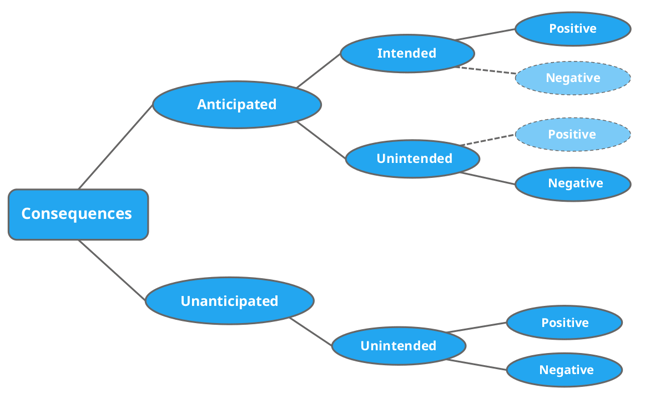Unanticipated and Undesirable Consequences of Innovation
When you innovate, you improve on the old. When you innovate, you discover something ground-breaking. When you innovate, the outcome benefits both you and the users of your product.
If you agree to those three statements, you just fell for one of the most common misconceptions of innovation, the "Pro-Innovation bias". Fortunately, or unfortunately, you are not alone with your thoughts.
The most cutting-edge research has revealed that only 0,1% of the written articles on innovation consider negative consequences of innovation. Within technological research in management literature, the number has slightly improved during the recent years. However, with 0,36% of the articles studying negative consequences to stakeholders, there is still room for improvement.
Those are interesting numbers, especially considering what this means in practice.
My intentions with this blog post is to challenge the standard perceptions about innovation, and to wake thoughts about "the other side of the spectrum".

Table of contents
To better understand the problem, we begin by investigating what innovation is. The definition of the concept is not clear as many thought patterns exist.
Some people restrict the definition of innovation to only the first example I showed in the beginning of this blog, only improvements are innovation. Others define it by novelty. Only the first can be called innovation, anything else is copying. These two approaches raise problems and questions.
What should those developments, that do not improve on the previous, be called? How about outcomes that were not anticipated, are those too innovation or are they simply events of fortuity?
To investigate the problem at hand, the broadest definition is the most suitable. Innovation is everything new to a specific group or instance. The introduction of new, albeit a new interpretation of something already existing or simply a slight improvement, can cause negative consequences to different stakeholders.
With this description, I will first go through the concepts behind unanticipated and undesirable consequences of innovation as well as define and explain different parts of the problem.
In the following section, I introduce the different effects that have been found to impact the outcomes of innovation. Finally, I leave you with thoughts on improving practices to limit unanticipated and undesirable outcomes.
Concepts behind unanticipated and undesirable consequences of innovation
Unanticipated or unintended
What makes an innovation unanticipated and undesirable? Taking the first part, unanticipated, and breaking it down into the roots is a more complex task than one would initially expect.
I mean, unanticipated, something that one has not thought of and has no foreknowledge of before introducing something, is not hard to grasp. However, studies have shown that decision-makers and developers shy away from expressing something as unanticipated, especially with undesirable consequences and effects.
Most researchers, decision-makers and innovators default to saying that something unanticipated was unintended instead. Paradoxical, yes, but very common!
The problem lies within the semantics, something unintended can be both anticipated and unanticipated.
However, something intended cannot be unanticipated, you cannot intend for something to happen and not anticipate it at the same time. Intention infers knowledge and without knowledge, you cannot intend for something to happen.
A deeper discussion on this topic can be found behind the link, but is not possible within this post. However, I emphasize that the events I am talking about in this post are unanticipated, not unintended. By emphasizing events as unanticipated, I express that I am going to study events and effects without foreknowledge!
When going through with something, the actors had no foreknowledge about the outcomes. The duality of the word unintended is illustrated in the graph below. On the unanticipated branch, unintended can just as well be omitted and it would not change the meaning of the graph.

Undesirable
By undesirable, within the boundaries of this blog, I mean undesirable to the stakeholders of the innovation. Much of innovation is about making your products generate more revenue and profits. Yes, innovation can affect the business, but sometimes it is beneficial to think about your stakeholders as well.
With happy stakeholders, one of the most important marketing channels will improve by increasing the likelihood of word-of-mouth marketing. Happy customers and happy stakeholders talk about the products they use, and the experiences they have had. By turning your attention toward your stakeholders and how your activities affect them, you can find important shortcomings and improvement ideas where your current actions are lacking.
Diffusion
"Most of the undesirable consequences emerge when the innovation is widely diffused and never comes to the attention of the innovator"
– Everett M. Rogers
The quote raises the first problem of studying unanticipated consequences. An innovation might seem good at first, but when it diffuses, more and more stakeholders come into contact with the innovation and its consequences.
Reasons for the negative consequences are therefore sometimes hard to study and longitudinal methods are needed where an innovation is followed from its introduction to the end of its lifetime. This might be one of the reasons the phenomenon of unanticipated and undesirable consequences is such unknown.
Nevertheless, the importance of addressing the issues still persists. Pioneers adopting an innovation might only use the product as it was intended, but further adopters might use it differently than its first intentions were. The product, method or service could end up in use in other environments, or with different target audiences than the creator had initially thought of, resulting in unanticipated events.
Effects leading to unanticipated consequences of innovation
I categorized my findings into five categories of effects that lead to or contribute to unanticipated undesirable consequences. These are: Lack of foreknowledge, habit, myopia, basic values, and self-defeating predictions.
Lack of foreknowledge, an effect that is easy to fall back to as an explanation, explains unanticipated consequences as an effect of not having enough foreknowledge about what you are about to change.
While innovating, you can get excited about the new you are about to change, and in the excitement, push it forward fast without properly researching possible consequences and outcomes. "If I only knew more, I would have done differently", an expression that is commonly given as an explanation. Without foreknowledge, negative consequences that can emerge are plenty.
For example, introducing mobile communication applications into the everyday workflow of the employees can introduce unwanted consequences. Research has found several examples where communication applications and devices lead to increased stress due to a constant inflow of messages and notifications. Additionally, due to the increased stress fatigue, physical and psychological health issues appear. Several other unanticipated and undesirable consequences can be attributed to this effect.
Habit, doing something through the means of habit when something sudden and unexpected happens instead. When developing a habit within the tasks you are doing, it is easy to fall for simple mistakes causing undesirable consequences.
Habit can additionally result in undesirable behavior, which causes negative consequences to stakeholders. Through such behavior, either the stakeholder is creating the undesirable consequence to him or herself, or the undesirable effect is because of habitual behavior of employees. With certain innovations, stakeholders can experience unanticipated and undesirable consequences as a result of other stakeholders' actions.
Myopia, going through with something while only expecting one or a few desirable outcomes. Neglecting to think about other possible outcomes of an action, or an innovation, causes unanticipated consequences. Actions and innovations have consequences, and several of them have to be weighed and considered before going through with an innovation.
By developing something through blindly following only one goal, unanticipated consequences are almost inevitable. The possibilities are wide depending on the industry and practice used. An example of this effect could be a system-wide development, where the sole goal is to streamline the production without considering system usability. While several improvements might improve the reporting, usability could suffer.
Basic values, innovating with the sole purpose of improving on something that you care about, while purposefully neglecting other outcomes. This is different from myopia as with this effect, some of the consequences that are negative are known before implementation. The drive to improve on something you care about does, however, also result in more unanticipated consequences.
A classic example of this effect from manufacturing practices, is a desire to get increased production during the night shift. Increasing the production during the night shift then leads to the day shift fixing possible stress related defects in the production equipment, finally nullifying the total gain by the night shift. Neglecting to see a bigger picture clouds your ability to realize all the possible outcomes.
Finally, self-defeating predictions, an effect that explains outcomes where an innovator predicts something negative, which later comes through because the prediction was made. You could, for example, predict that a certain implementation is too complex for anyone to fully understand it. This prediction could then come to pass in the form of employees actually fearing the development, as belief in this prediction increases with time.
Example case of unanticipated and undesirable consequences
The first case that came into my mind to illustrate an unanticipated and undesirable consequence, was the introductory case my professor gave me before starting my research on this topic within a research team.
In the 1980s, it was discovered that the common coolant within refrigerators, CFC, is destroying the ozone layer. Perhaps even the replacing agent HFC, according to the recent study by NASA. Before the discovery, CFC was considered a very successful innovation that increases the effectiveness of refrigerators.
Presumably, the intentions of the innovators were to improve the effectiveness of the refrigerator, rather than to destroy the ozone layer. The consequences are therefore unanticipated and undesirable due to one or more of the aforementioned effects.

What is there to be done?
Going further on this topic is more difficult. Research is currently only beginning to investigate the patterns and reasons that lead to unanticipated and undesirable consequences.
Cases are gathered for analysis where the purpose is to understand the connections between these effects and consequences, and possibly find new effects, to then explain what leads to unanticipated undesirable consequences. Though models have been proposed, it has not been conclusively determined, how avoiding major err would be possible.
Within our blogs, open innovation and shared collaboration has been encouraged in several posts. Being open and involving many into each project introduce many minds with different views and perspectives on the subject. Giving each participant the chance to express thoughts and concerns can eliminate some of the aforementioned effects. More about open innovation implementations can be found in our post where diversity and multidisciplinarity is emphasized. Engaging many cultures within your projects can improve your chances to spot and fix problems before they emerge.
Open innovation is not the only thing that could be done. Employee engagement is a core aspect of successful ideation, especially with intents of including several views and opinions within projects. The more employees are engaged, the more they can think about outcomes of the idea. For this, a process of employee engagement can be utilized. Employee motivation is also a concern within the discussion of engagement. By considering engagement, and embracing change, you can improve your outcomes of future ideation.
With the following questions, I leave you to more considerate innovation practices. Have you experienced such unanticipated and undesirable consequences? Are you certain about the effects which lead to those consequences, and could they have been avoided in some way?
Interested in Innovation and Leadership?
Subscribe to our blog to get the latest stories on innovation, leadership and culture straight to your inbox.







